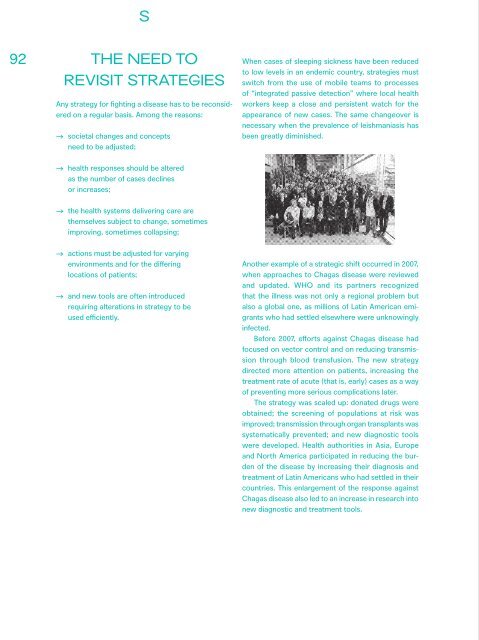You also want an ePaper? Increase the reach of your titles
YUMPU automatically turns print PDFs into web optimized ePapers that Google loves.
S<br />
92<br />
<strong>THE</strong> NEED TO<br />
REVISIT STRATEGIES<br />
Any strategy for fighting a disease has to be reconsidered<br />
on a regular basis. Among the reasons:<br />
→ societal changes and concepts<br />
need to be adjusted;<br />
When cases of sleeping sickness have been reduced<br />
to low levels in an endemic country, strategies must<br />
switch from the use of mobile teams to processes<br />
of “integrated passive detection” where local health<br />
workers keep a close and persistent watch for the<br />
appearance of new cases. The same changeover is<br />
necessary when the prevalence of leishmaniasis has<br />
been greatly diminished.<br />
→ health responses should be altered<br />
as the number of cases declines<br />
or increases;<br />
→ the health systems delivering care are<br />
themselves subject to change, sometimes<br />
improving, sometimes collapsing;<br />
→ actions must be adjusted for varying<br />
environments and for the differing<br />
locations of patients;<br />
→ and new tools are often introduced<br />
requiring alterations in strategy to be<br />
used efficiently.<br />
Another example of a strategic shift occurred in 2007,<br />
when approaches to Chagas disease were reviewed<br />
and updated. WHO and its partners recognized<br />
that the illness was not only a regional problem but<br />
also a global one, as millions of Latin American emigrants<br />
who had settled elsewhere were unknowingly<br />
infected.<br />
Before 2007, efforts against Chagas disease had<br />
focused on vector control and on reducing transmission<br />
through blood transfusion. The new strategy<br />
directed more attention on patients, increasing the<br />
treatment rate of acute (that is, early) cases as a way<br />
of preventing more serious complications later.<br />
The strategy was scaled up: donated drugs were<br />
obtained; the screening of populations at risk was<br />
improved; transmission through organ transplants was<br />
systematically prevented; and new diagnostic tools<br />
were developed. Health authorities in Asia, Europe<br />
and North America participated in reducing the burden<br />
of the disease by increasing their diagnosis and<br />
treatment of Latin Americans who had settled in their<br />
countries. This enlargement of the response against<br />
Chagas disease also led to an increase in research into<br />
new diagnostic and treatment tools.


